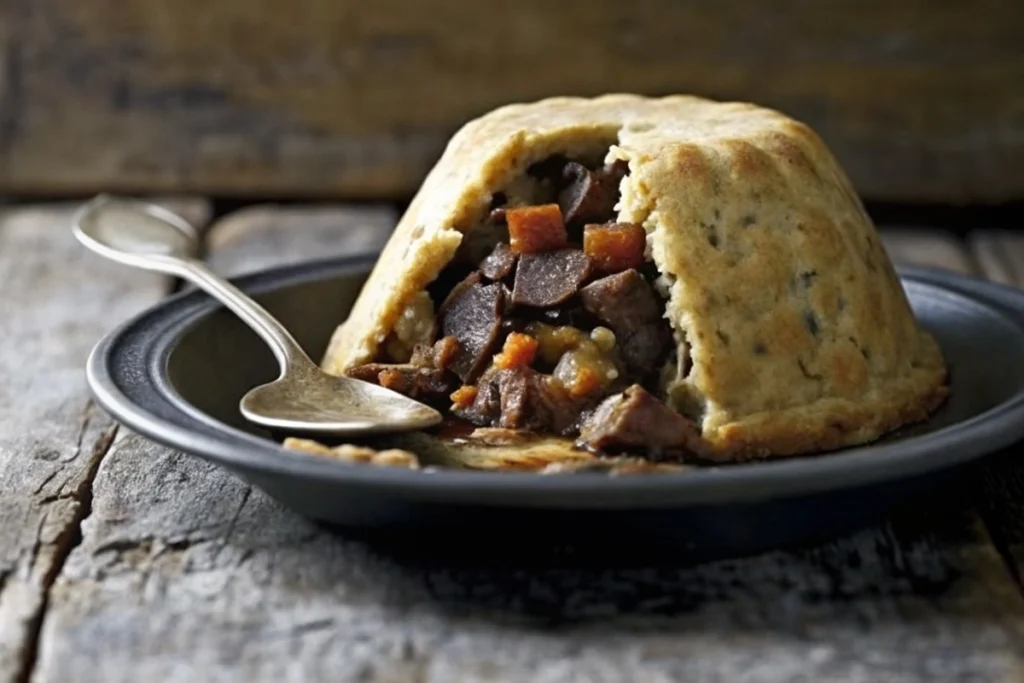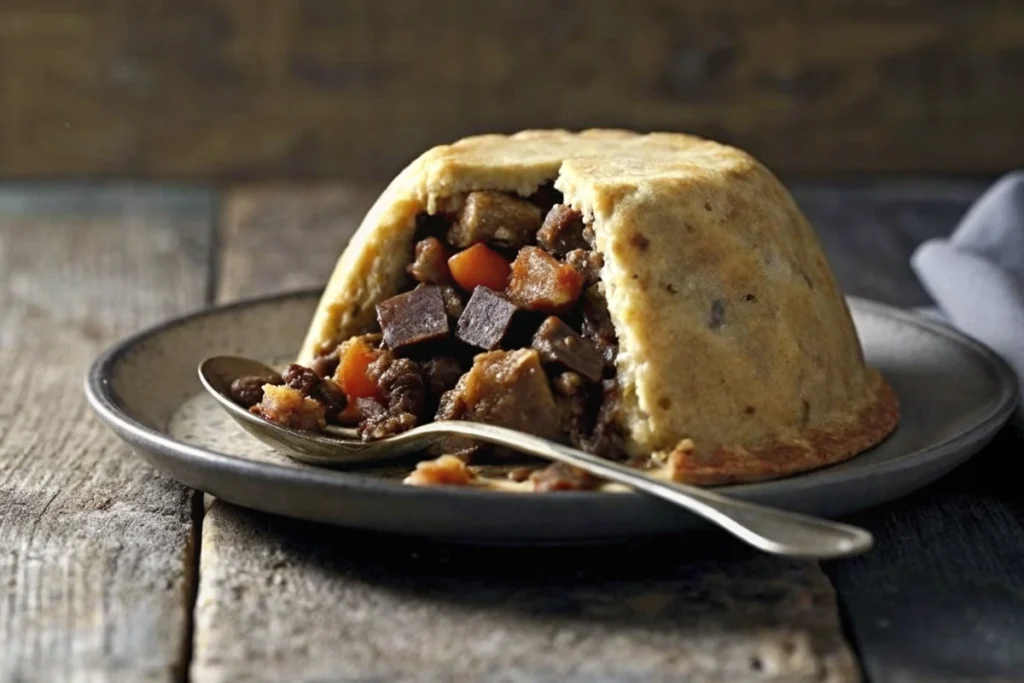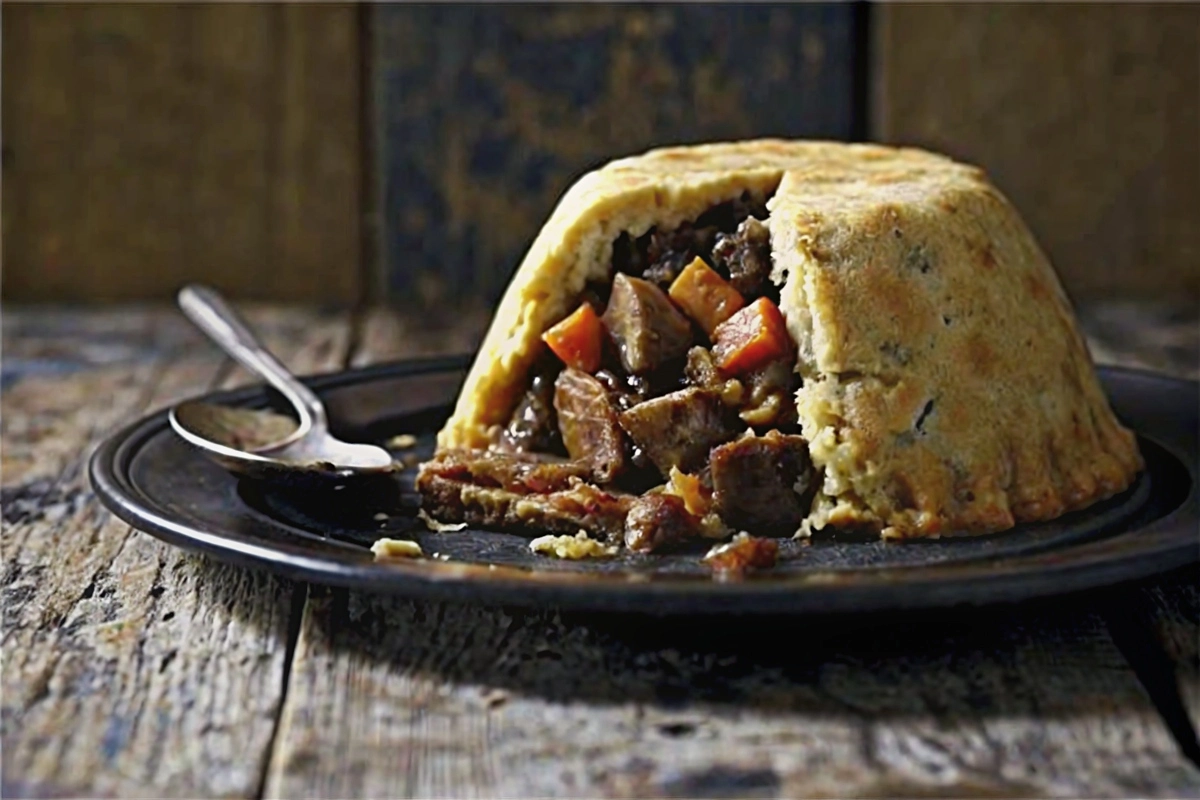Discover the art and tradition behind the Steak and Onion Steamed Pudding, a quintessential dish that embodies the rich heritage of British cuisine. In this article, we journey through the history, preparation, and unique techniques that make this dish a treasured comfort food. Every aspect of its creation—from the carefully selected ingredients to the meticulous steaming process—is steeped in tradition and innovation, making it a must-try recipe for enthusiasts of classic British fare.
A Glimpse into History and Tradition
The origins of the Steak and Onion Steamed Pudding can be traced back to the hearty kitchens of Britain, where resourcefulness and flavor merged to create a dish that would stand the test of time. In a period when meals were crafted with an emphasis on both sustenance and ingenuity, this steamed pudding became a staple in many households, particularly during the tougher times of war and rationing.
- Historical Roots:
The concept of a steamed pudding is not new. It evolved from the necessity to create a filling, economical meal that could be prepared using minimal resources. Over time, the simple pudding base was elevated by the addition of succulent pieces of steak and sweet, caramelized onions, transforming it into a dish that resonates with both nostalgia and culinary expertise. - Cultural Significance:
This dish is a celebration of British culinary heritage. It reflects the creative spirit of home cooks who turned limited ingredients into something extraordinary. The pudding was traditionally prepared in special basins and steamed for hours, allowing the flavors to meld into a comforting, savory delight.
For more insights into how this dish fits into the broader tapestry of British cuisine, check out Historical Insights into British Cuisine for an engaging look at traditional recipes that have shaped the culinary landscape of Britain.
The Science of Steaming: An Essential Technique
One of the most fascinating aspects of the Steak and Onion Steamed Pudding is its reliance on the art of steaming. This method is not only vital for preserving moisture and texture but also plays a key role in melding the flavors of the steak, onions, and pudding base.
- Steaming Advantages:
- Moisture retention: Steaming helps lock in the natural juices of the steak and onions, ensuring that each bite is rich and flavorful.
- Flavor integration: As the pudding steams, the ingredients harmonize, resulting in a complex yet balanced flavor profile.
- Traditional technique: Steaming is a time-honored method in British cooking, often seen in Steak and Onion Steamed Pudding passed down through generations.
For a more in-depth understanding of how this process works and why it is so essential to many classic recipes, you might explore pineapple ginger marinated flank steak Techniques, which delves into the physics and benefits of this cooking method.
- The Role of Equipment:
The traditional preparation involves using a pudding basin—a special mold that withstands the prolonged heat of steaming. These basins come in various sizes, but each is designed to allow steam to circulate evenly, ensuring that the pudding cooks uniformly. - Key Techniques:
- Preheating: The water in the steamer must be brought to the right temperature before the pudding is placed inside.
- Sealing: Properly covering the basin is crucial to trap the steam. Traditionally, this is done using greaseproof paper or foil, followed by a secure lid or cloth to hold everything in place.
- Timing: The pudding must be steamed for a specific duration—usually several hours—to achieve the perfect texture.
Understanding these techniques and equipment is essential for anyone looking to recreate this classic dish in their kitchen.
Ingredients: The Building Blocks of Flavor
At the heart of the Steak and Onion Steamed Pudding lie its simple yet high-impact ingredients. Each component plays a crucial role in defining the dish’s character and taste.
- The Steak:
- Selection: A well-marbled cut of steak is ideal for this recipe, as it provides both flavor and tenderness.
- Preparation: The steak is typically seared to develop a rich, caramelized crust before being incorporated into the pudding.
- Flavor contribution: Its robust taste serves as the centerpiece of the dish, infusing every bite with a savory depth.
- The Onions:
- Varieties: Traditional recipes often call for sweet or yellow onions, which are perfect for slow cooking.
- Preparation: Onions are sliced and caramelized until they achieve a soft, sweet flavor that complements the savory meat.
- Texture and aroma: When steamed together with the steak, the onions not only contribute a pleasant sweetness but also add to the overall aroma of the Steak and Onion Steamed Pudding.
- The Pudding Base:
- Composition: The base is a mixture of flour, suet (or its modern alternatives), and a rich meat stock.
- Consistency: This mixture creates a dense, yet tender, pudding that holds together well during the steaming process.
- Enhancements: Herbs and seasonings are often added to the base to elevate the flavor profile, making each spoonful a delightful experience.
- Substitutions and Variations:
For those seeking to experiment with the recipe, various substitutions can be made:- Replace suet with butter for a slightly different texture.
- Experiment with different cuts of steak to find the balance of flavor and tenderness that suits your palate.
- Consider adding aromatic herbs like thyme or rosemary to complement the rich flavors.

Each ingredient is chosen with care to ensure that the final product is both hearty and refined, capturing the essence of a time-honored British recipe.
Mastering the Preparation and Cooking Process
The secret behind a perfect Steak and Onion Steamed Pudding lies in its meticulous preparation and the precise execution of the steaming process. Here is a comprehensive, step-by-step guide to achieving that authentic, mouthwatering result.
Step 1: Prepping the Ingredients
- Prepare the Steak:
- Trim and cut: Begin by trimming any excess fat from the steak and cutting it into bite-sized pieces.
- Season: Generously season the steak with salt, pepper, and your favorite herbs.
- Sear: Quickly sear the steak in a hot pan until a golden crust forms. This not only locks in the juices but also creates a flavor-rich foundation.
- Caramelize the Onions:
- Slice thinly: Cut the onions into thin, even slices.
- Slow cook: In a separate pan, slowly cook the onions with a bit of oil or butter over low heat until they turn a deep golden brown. This process enhances their natural sweetness and softens their texture.
- Deglaze: For extra depth, deglaze the pan with a splash of stock or wine, scraping up any browned bits.
Step 2: Assembling the Pudding
- Mix the Base:
- Combine dry ingredients: In a large bowl, mix flour and suet along with a pinch of salt and your chosen herbs.
- Incorporate stock: Gradually add in the meat stock to form a thick, cohesive batter.
- Integrate ingredients: Fold in the seared steak and caramelized onions, ensuring an even distribution throughout the mixture.
- Prepare the Pudding Basin:
- Grease the basin: Lightly grease a traditional pudding basin to prevent sticking.
- Fill: Transfer the pudding mixture into the basin, smoothing the top to ensure an even surface.
- Cover: Seal the basin with a layer of greaseproof paper, then secure it with foil or a cloth to lock in the steam.
Step 3: The Steaming Process
- Set Up the Steamer:
- Boil water: Fill a large pot with water and bring it to a boil. Ensure the water level is high enough to generate ample steam throughout the cooking process.
- Place the basin: Gently lower the pudding basin into the pot, making sure it is not submerged but sits high enough above the water to allow for even steaming.
- Steam to Perfection:
- Monitor the time: The pudding needs to steam for several hours (typically between 2 to 3 hours) to ensure it is fully cooked and reaches the desired consistency.
- Check occasionally: Carefully check the water level to make sure it doesn’t evaporate completely; add more water as needed.
- Final check: Once the steaming time is complete, carefully remove the basin from the pot. Allow it to cool slightly before turning it out onto a serving plate.
- Key Tips for Success:
- Maintain consistent heat: Ensure the water remains at a steady boil without sudden fluctuations in temperature.
- Avoid overfilling: Do not overfill the pudding basin; a moderate amount allows the pudding to cook evenly.
- Practice patience: Remember that slow cooking is the key to melding the flavors and achieving the perfect texture.

The process of preparing and steaming the pudding is as much an art as it is a science. Each step is crucial in ensuring that the final Steak and Onion Steamed Pudding is a harmonious blend of savory steak, sweet onions, and a perfectly textured pudding base.
Celebrating Regional Variations and Modern Twists
While the traditional Steak and Onion Steamed Pudding remains a beloved classic, numerous regional variations and modern adaptations have emerged over the years. These tweaks not only keep the recipe fresh and relevant but also allow home cooks to inject their creativity into this timeless Steak and Onion Steamed Pudding.
- Regional Twists:
- In various parts of Britain, local ingredients and cooking methods have influenced slight variations in the recipe. For example:
- Northern Variations: Some regions might add a hint of smoked bacon or a splash of ale to deepen the flavor profile.
- Southern Approaches: In other areas, lighter cuts of meat or alternative herbs such as sage might be used to bring a more delicate balance.
- These variations illustrate the versatility of the dish, proving that while the foundation remains constant, the interpretation can evolve with regional tastes and available ingredients.
- In various parts of Britain, local ingredients and cooking methods have influenced slight variations in the recipe. For example:
- Modern Adaptations:
- Contemporary chefs have embraced the tradition of steaming while experimenting with new flavor combinations and presentation styles.
- Creative Enhancements:
- Adding seasonal vegetables like carrots or parsnips to the mix can introduce new layers of texture and taste.
- Experimenting with different herbs such as rosemary or thyme allows for a more aromatic experience.
- Fusion Ideas:
- Some innovative recipes blend the traditional steamed pudding with international influences, such as incorporating a dash of soy sauce or ginger to create a fusion dish that respects its roots while exploring new culinary territories.
- Bullet Points for Adaptations:
- Experiment with meat cuts: Try using leaner or more flavorful cuts for different textures.
- Herbal variations: Swap out traditional herbs for modern, aromatic alternatives.
- Seasonal adjustments: Incorporate vegetables that are fresh and in season to enhance the dish.
Presenting Your Steak and Onion Steamed Pudding with Flair
Presentation is a vital part of any meal, and the Steak and Onion Steamed Pudding is no exception. The visual appeal of a well-plated dish can enhance the dining experience, making it as much a feast for the eyes as for the palate.
- Serving Suggestions:
- Traditional Pairings:
- Serve the pudding with classic sides such as mashed potatoes, roasted root vegetables, or a light seasonal salad.
- A rich, savory gravy often accompanies the Steak and Onion Steamed Pudding, further intensifying the flavors.
- Modern Twists:
- Experiment with plating by slicing the pudding into elegant portions, garnished with a sprig of fresh thyme or rosemary.
- For a contemporary look, consider serving the dish on a minimalist white plate that contrasts with its hearty, rustic nature.
- Bullet Points for Presentation:
- Plating: Consider slicing the pudding into neat wedges.
- Garnish: Use fresh herbs to add a splash of color.
- Side dishes: Pair with complementary sides that enhance the overall meal experience.
- Traditional Pairings:
- Enhancing the Dining Experience:
- A thoughtful presentation can elevate the dish from a simple meal to a culinary experience. Consider the following tips:
- Attention to Detail:
Every element on the plate should be arranged with care. The rich, savory aroma of the pudding combined with its inviting appearance creates an unforgettable dining experience. - The Finishing Touch:
A drizzle of homemade gravy or a sprinkle of finely chopped herbs can transform the Steak and Onion Steamed Pudding into a work of culinary art.
- Attention to Detail:
- A thoughtful presentation can elevate the dish from a simple meal to a culinary experience. Consider the following tips:

Frequently Asked Questions About Steak and Onion Steamed Pudding
Here are some of the most common questions home cooks ask when embarking on their Steak and Onion Steamed Pudding journey:
- What exactly is Steak and Onion Steamed Pudding?
- It is a traditional British Steak and Onion Steamed Pudding that combines tender pieces of steak and sweet onions within a rich, savory pudding base, all cooked using the method of steaming.
- How do I achieve the perfect texture?
- The key lies in:
- Proper searing of the steak to lock in juices.
- Slow caramelization of the onions.
- Maintaining a consistent, gentle steam for several hours to allow the flavors to meld and the pudding to set perfectly.
- The key lies in:
- Can I prepare it ahead of time?
- Yes, the pudding can be made in advance. Once steamed, allow it to cool, then store it in an airtight container. When reheated, the pudding retains its flavor and texture remarkably well.
- What are some common pitfalls to avoid?
- Some frequent issues include:
- Overfilling the pudding basin can lead to uneven cooking.
- Not maintaining a steady steam, can result in a dry or undercooked pudding.
- Rushing the process—the slow, careful steaming is crucial for melding the flavors.
- Some frequent issues include:
- Are there any creative twists I can try?
- Absolutely. Consider experimenting with:
- Different cuts of steak to explore various textures.
- Alternative herbs and spices that align with your flavor preferences.
- Seasonal vegetables that can be subtly incorporated into the pudding base for added depth.
- Absolutely. Consider experimenting with:
- How do I ensure a consistent result every time?
- Follow these tips:
- Measure ingredients carefully: Consistency in the mixture ensures even cooking.
- Monitor the steaming time: Avoid rushing or extending the steaming process beyond what is needed.
- Use a reliable pudding basin: Traditional, well-maintained equipment can make a significant difference in the final product.
- Follow these tips:
Final Thoughts on Crafting a Classic Dish
The Steak and Onion Steamed Pudding is more than just a recipe—it’s a journey into the heart of British culinary tradition. From its humble origins during challenging times to its evolution into a beloved comfort food, every element of this dish tells a story of resilience, creativity, and passion.
- A Culinary Journey:
- Each ingredient and every step of the process is steeped in history, inviting you to be part of a long tradition of home cooking.
- As you prepare the pudding, think of it as more than just food; it is a bridge connecting modern kitchens with the storied past of British culinary arts.
- Embrace the Process:
- Take your time with each phase of preparation—from the careful searing of the steak to the slow, deliberate steaming.
- Enjoy the ritual of cooking, knowing that each step contributes to a dish that is both comforting and sophisticated.
- Sharing the Experience:
- Invite family and friends to share in the experience of enjoying a meal that is as rich in history as it is in flavor.
- Encourage conversation about the origins of the Steak and Onion Steamed Pudding and the personal touches that each cook brings to it.
- Bullet Points for Final Reminders:
- Respect tradition: Honor the history behind each step of the recipe.
- Innovate confidently: Modern adaptations can enhance while staying true to the dish’s roots.
- Enjoy the journey: The process of preparing this pudding is as rewarding as the final taste.
Conclusion
In wrapping up this exploration of the Steak and Onion Steamed Pudding, it is clear that this dish remains an enduring symbol of British culinary heritage. Through a blend of tradition, technique, and a touch of modern creativity, it continues to delight those who appreciate a hearty, savory meal.
- Key Takeaways:
- The rich history of the pudding reveals much about the evolution of British cooking.
- Mastering the art of steaming is essential for achieving the ideal texture and flavor.
- Regional variations and modern twists ensure that the Steak and Onion Steamed Pudding classic dish remains dynamic and relevant.
- Encouragement to Experiment:
- Whether you adhere strictly to tradition or introduce your creative adaptations, the Steak and Onion Steamed Pudding is a dish that welcomes personalization.
- Every attempt at this Steak and Onion Steamed Pudding recipe is an opportunity to connect with a part of culinary history, making each meal a celebration of time-honored techniques and family traditions.
By following this guide, you will not only create a delicious meal but also become a part of a living culinary tradition that spans generations. Enjoy the process, and let each step be a reminder of the timeless charm of British cooking.


2 thoughts on “Ultimate 7-Step Steak and Onion Steamed Pudding: A Timeless British Classic”